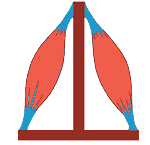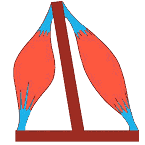

Injury Prevention
Back Pain: Prevention and Treatment
Sarah Serres, Amanda Marsh, Jenna Foral, and Allen Jackson of Chadron State College explore the prevention and treatment of back pain.
The human body is the entire physical structure of a human organism. One's phenotype (physiological properties) is first determined by genetics and, secondly, by postnatal factors such as diet and exercise. By the time the human reaches adulthood, the body has nearly 100 trillion cells. Each is part of an organ system designed to perform essential life functions. As we progress through the developmental stages of life, we are challenged by many conditions that can be prevented (Dunbar 2008)[3]. Regardless of the sport, one of the most common injury sites is the lower back region (Dunbar 2008)[2].
Everyone knows someone who experiences back pain or may be suffering from back problems themselves. Many Americans suffer from acute or short-term pain, which generally lasts a few days to a few weeks. It can interfere with daily routines, exercise activities, and careers. There are many causes for lower back pain; for example, weak or inflexible hamstrings in runners can often create problems with the most common cause, muscular strains. It happens when an unexpected force, twist, or pull is applied to one or several lower back muscles. Ligamentous sprains, another cause of the discomfort, occur when the back's ligaments are unduly stretched (Inverarity 2007)[9].
 Inverarity (2007)[9] stated that four out of five adults experience symptoms of lower back pain. The back comprises "33 vertebrae, over 30 muscles, numerous ligaments, multiple joints, and intervertebral discs". As seen, many structures can cause discomfort if injured or affected.
Inverarity (2007)[9] stated that four out of five adults experience symptoms of lower back pain. The back comprises "33 vertebrae, over 30 muscles, numerous ligaments, multiple joints, and intervertebral discs". As seen, many structures can cause discomfort if injured or affected.
Back pain causes limited flexibility and mobility and limits one's range of motion, so conditioning of the muscles that maintain posture should form part of everyone's training program, regardless of the discipline or sporting standard. (Dunbar 2008)[3]
Throughout this article, we will provide information that will help readers better understand the likelihood of suffering from back pain and how many of these conditions can be treated or prevented.
Nearly everyone is at risk of having back pain at some point in their lives. Approximately 70-80% of adults suffer from back pain. Studies conducted in Atlanta, Dallas, and Seattle showed that 37% of males experience back pain compared to 63% of females (McPhillips-Tangum 1998)[11]. For both genders, back problems often occur between the ages of 30 and 50, usually after most competitive activities are far behind us, with the blame being placed on the normal ageing process. (Ninds 2008)[12].
We strongly dispute the hypothesis that back problems are mainly due to ageing. In many situations, back pain is a direct result of muscular imbalances. If such imbalances are left unchecked, the discomfort may inhibit activity, thus contributing to a sedentary, inactive lifestyle. By strengthening and stretching the muscles of the lower back and abdominal regions, you can help reduce or prevent many problems leading to back pain (Inverarity 2007)[9].
Muscular Function
Muscles act much like guide wires by preserving the integrity of the skeletal system. Not only do muscles move bones, but they also hold the skeletal system together and maintain balance through dynamic tension in the musculoskeletal system. Skeletal balance is maintained by opposing muscles. When a muscle is weaker than the one opposing it, the opposing muscle becomes tight, and the body segment controlled by those muscles will be out of balance (Cuthbert 2008)[6].
|
|
Studies have shown that a high percentage of people with back pain have nothing more than tight back muscles as a result of somatic dysfunction, or more easily understood as a muscular imbalance between the lower back and abdominal muscles in correlation with the origin of a muscle, and mechanical postural dysfunctions (Duvall et al. 2008)[4]. Physical dysfunctions develop over time and are the direct result of imbalances between various muscle groups, called "muscle imbalances".
 Muscle Balance |
 Muscle Imbalance |
Back pain is real and, in all probability, the most common job-related injury or disability occurring in the United States and leading to missed work (Ninds 2008)[12]. Four out of every five women experience back pain severe enough to keep them from work. An estimated 72% of Caucasians living in the U.S. suffer from back pain, while Black Americans are rated second highest with 18%. Pacific Islanders were next with 7.4%, and Hispanic Americans last with 1.9% (McPhillips-Tangum 1998)[11].
We have already discussed some causes of back pain, with muscle strain leading the list. Strains often result from sports, housework, lifting children, or simple overuse. We feel that muscle strain can be significantly minimised with a well-designed training program that addresses the strength and endurance of the anterior and posterior core and hip area.
An injury is another cause; this includes a direct injury to the back or spinal column or a sudden jolt sustained in a car accident. Other causes include stress, pregnancy, inappropriate posture, and poor sleeping positions. Again, proper conditioning that would address both the lower back and abdominal areas would minimise back problems relating to the mentioned factors.
Weight gain and obesity also contribute to back pain (Ninds 2008)[12]. Still, regardless of overuse, injury, stress, or pregnancy, the main reason is that muscles acting in unison (agonists vs antagonists) are typically out of balance regarding strength and endurance. These imbalances occur when specific muscles are overdeveloped in one body area while the opposing muscles (antagonists) are weak and stretched out of their normal position. Muscular imbalances happen anywhere in the body and often develop due to improper training of the muscle groups, thus affecting our daily routine. Many treatments are available for all kinds of back pain, including surgery, anti-inflammatory drugs, over-the-counter pain relievers, hot and cold compressions, or even deep tissue massage. While some of these treatments may cure back pain, the best way to reduce or stop back pain is through exercise programs that address balancing the muscular system.
Muscle balance is a vital component of injury prevention. Regardless of your choice of exercise, you must focus on muscle balance. Muscle groups work in pairs, and there needs to be a balance in training the agonist and the antagonist muscle group for each body segment, resulting in equality regarding strength and flexibility. For example, we flex the elbow using the biceps and antagonistic muscles, and the triceps control the contraction. The triceps muscle must be willing to stretch for the bicep muscle to contract for flexion at the elbow (Delzeit 2002)[2].
Muscle balance focuses on eliminating the strength imbalance between two opposing muscle groups. It is essential to prevent injury and assist in developing maximum speed and improved performance. This may also be a limiting factor in overall speed development for young athletes. As coaches and trainers, we must be aware of Muscular balance testing to compare the strength of opposing muscle groups. If not addressed through a well-thought-out, disciplined training program, muscle imbalances can slow down and possibly injure the young athlete (Mackenzie 2008)[10].
Minimizing the Risk
Anyone can benefit from stretching the muscles, ligaments, tendons, and soft tissues of the human body. Anyone who suffers from back pain should focus on stretching the neck, back, hips, glutes, and hamstrings. All of these areas are important in support of the spinal column. It is important to stretch correctly by moving into all stretches slowly and avoiding bouncing. You should feel the muscles stretching, but it should not cause pain. Hold the stretch for 30-45 seconds, allowing the muscles and joints to become loose. It may take a few weeks or even months of stretching to notice the change in spinal mobility, but back pain relief should follow (Ullrich 2007)[13] (Ullrich 2007a)[14].
Flexion exercises stretch the muscles and ligaments in the back and neck and strengthen stomach muscles. These types of activities are best for people who find relief by sitting down (Ullrich 2007)[13] (Ullrich 2007a)[14].
An example of a flexion stretch is the chin-to-chest stretch. Begin in a standing or sitting position, gently bending the head forward while bringing the chin toward the chest until a stretch is felt in the back of the neck (Ullrich 2007)[13] (Ullrich 2007a)[14]. The back flexion exercise is another example; begin lying on one's back and pull both knees to the chest simultaneously while flexing the head forward until a comfortable stretch is felt in a balled-up position (Ullrich 2007)[13] (Ullrich 2007a)[14].
Low-impact aerobic exercise is another way to improve the function of the back. Performing 30-40 minutes of aerobic exercises can release endorphins, a biochemical of the body that is a natural painkiller. This can help reduce the pain and also help decrease the dependency on prescribed pain medication. Low-impact aerobic exercises such as walking, elliptical training, swimming, water aerobics, and stationary biking are recommended (Ullrich 2007)[13] (Ullrich 2007a)[14]. However, when people start an aerobic exercise plan, they should start with shorter, easier workouts and then increase the time as they proceed and the back pain lessens (Erstad 2006)[7].
Strengthening exercises for back pain are important because they help relieve the pain, speed up the recovery process, and strengthen the back. When performing any activity, the first thing to remember is to use the proper form to prevent further injury. Never perform an exercise where the back is not supported.
Strengthening exercises can include extension and flexion exercises. Extension exercises strengthen back muscles and help to stretch the tissue along the spine. These exercises are best for people who find relief by standing and walking. Examples include the press-up back extension and alternating arm and leg exercises (Erstad 2006)[7]. The press-up back extension can be performed on a machine with weights or with one's body weight. The alternating arm and leg exercise can be done by lying flat on one's back and bringing up the right arm and left leg together for a count of one, then repeating the step with the opposite side.
There are many everyday things to consider to help decrease back pain. Simple and effective techniques are discussed to prevent pain and a trip to the doctor's office. First, each person should consider the position of their spine, which should be neutral. Practice standing with your back, shoulders, and heels against a wall. Second, ensure you sit correctly with your back up tall and your hips and knees at a 90-degree angle. Women should consider the amount of weight they have in their purses and decide what is needed and what is not. Women carrying more than 5 to 10 pounds in their purses have a higher chance of back pain.
The bones, muscles, and ligaments in our backs are needed to function in our everyday lives; they must not be taken for granted. Remember that there are many remedies to help reduce and relieve back pain and many steps to reduce the risk of developing chronic back pain. Consider some of these exercises and examples that we have provided; however, please consult your doctor before attempting any exercise.
References
- ALEXANDER (n.d) Precision muscle balancing technology-in brief. The Institute of Precision Muscle Balancing
- DELZEIT, L. (2002) Aqua aerobics class. [WWW] Available from: https://wellness.lattc.edu/aquatics/aqua.html
- DUNBAR, J. (2008) Abdominal muscle exercises, lower back pain exercises and injury prevention. Peak Performance
- DUVALLl, R. et al. (2008) How to finally get lasting pain relief. The Healthy Back
- COHEN, I. (2002) Aggressive exercise as a treatment for chronic low back pain. Sports Med, 32 (1), p. 75-82
- CUTHBERT, S. (2008) The Professional use of Applied Kinesiology manual muscle testing. Applied Kinesiology: Rationale, Science and Evidence
- ERSTAD, S. (2006) Low back pain: exercises to reduce pain. [WWW] Available from: https://www.revolutionhealth.com/healthy-living/fitness/injuries/back-pain/lower-back-pain
- GLUCKMAN, G. (2008) Muscle balance and function development. [WWW] Available from: https://www.musclebalancefunction.com/biography.html
- INVERARITY, L. (2007) Common causes of back pain. WWW] Available from: https://physicaltherapy.about.com/od/backpain/a/Causesbackpain.htm
- MACKENZIE, B. (2008) Muscle strength and balance checks. [WWW] Available from: https://www.brianmac.co.uk/sambc.htm
- McPHILLIPS-TANGUM, C. (1998) Reasons for repeated medical visits among patients with chronic back pain. J Gen Intern Med. 13 (5), p. 289-295.
- NINDS (2008) Low back pain. National Institute of Neurological Disorders and Stroke
- ULLRICH, P. (2007) Low-impact aerobic exercise. [WWW] Available from: https://www.spine-health.com
- ULLRICH, P. (2007a) Stretching for Back Pain Relief. [WWW] Available from: https://www.spine-health.com
Page Reference
If you quote information from this page in your work, then the reference for this page is:
- JACKSON, A. et al. (2009) Back Pain: Prevention and Treatment [WWW] Available from: https://www.brianmac.co.uk/articles/article052.htm [Accessed
About the Authors
Sarah Serres, Amanda Marsh, and Jenna Foral are upper-level students at Chadron State College and plan on going into exercise-related professions.
Allen Jackson is an assistant professor with the Department of Health, Physical Education, and Recreation at Chadron. He encourages learners to voice their opinions and share ideas with the educational community.

